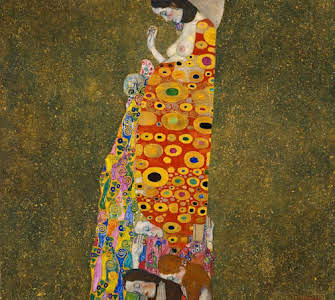Boundary-breaking encounters bring us in touch with both the power of creation and the possibility of oblivion. Rituals of embrace protect us and help our survival and return. View the study sheet here. View the zoom recording here.

For most of human history the moment of birth presented death as at least as much of a possibility as life. Haunting every labor was the question: Would the outcome be loss and sorrow or blessing and joy?
The hovering presence of death at birth existed well into the twentieth century in both Europe and the United States. Pictured here is Gustav Klimt’s Hope II. A pregnant woman bows her head and closes her eyes, perhaps praying for the safety of her child. At her feet are three women. They too bow their heads and raise their hands, beseeching goodness to prevail. Peeking out from behind the pregnant woman is death’s head. The outcome hangs unresolved.
Klimt painted in Vienna around 1900, when life for that city also seemed to be hanging in the balance. A mere 40 years before Klimt painted Hope II, great new life had swept through the city. Kaiser Franz Joseph had torn down the city’s old medieval walls and replaced them with the Ringstrasse. That masterpiece of urban planning ended aristocratic stranglehold over city life and opened it to the middle class. Jewish society in particular, recently granted full legal rights, built magnificent homes in the Ringstrasse. There they opened salons that nurtured literary, musical, artistic, and philosophical creativity.
Yet, by 1897 the shadow of death loomed ever larger over Vienna’s cityscape. That year Karl Leuger, campaigning on a virulent anti-Semitism platform, was elected mayor. Serving until 1910, Leuger imbedded political anti-Semitism as a dominant social force into everyday social life in Vienna. Four years later Austrian Archduke Ferdinand was assassinated, igniting the flames of World War I. And a few years after that, a former art student from Vienna who had feasted at the table of Leuger’s rabid anti-Semitism, built the even more monstrous flames of the Shoah.
Hope II is more than a portrait of a woman about to give birth. Klimt painted it in a time and place where the possibility of life renewed and that of life destroyed vied for ascendancy. The incapacity of those who dwelt in that moment to restrain the power of death enabled new life to be crushed into oblivion.
Parshat Tazria-Metzora opens with a meditation on a woman about to give birth. It is a moment of anxiety for her. No longer dwelling in mere finiteness, she dwells in a threshold between worlds. Child birth is a boundary-breaking experience, touching upon the Infinite and its power of creation. And obliteration is also possible in that moment. Life and death, ritual purity and impurity, pleasure and pain have become inextricable from each other. Such an indeterminacy requires a protocol for a healthy resolution. After the birth, the mother brings two offerings: one of elevation and one of restoration. Having touched the infinite, she resettles herself in the world of boundaries.
We live surrounded by shredding boundaries. It is a world that holds out the possibilities of new life. And also the possibility of oblivion. The offerings detailed in Tazria-Metzora are not ours to adopt. Nor is Klimt’s golden embrace one for our age. Every generation must find a way to both go beyond and return home.
Join us here at 7:00 p.m. (PT) Thursday April 20 as we explore at the threshold.
Oil, gold and platinum on canvass Hope II by Gustav Klimt








